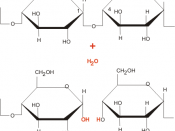Introduction
Enzymes are proteins that are involved in all the chemical processes in living things. As they are made of proteins they are affected by pH and temperature. Enzymes are catalysts; they speed up chemical reactions without being changed themselves. Digestive enzymes speed up the breakdown of large food molecules into smaller ones so that the blood can absorb them. Enzymes turn a large starch molecule into thousands of tiny glucose molecules. Enzymes end in 'ase'. There are thousands of enzymes in our body but each enzyme is only specialised to do one thing, for example carbohydraise enzymes digest carbohydrates, protease enzymes digest protein.
Prediction
I predict that the amylase will digest the starch the best and the quickest at around room temperature, (35 C-45 C). I have come to this prediction because I think that enzymes are more active around room temperature. I don't think that any starch will be digested at 100 C as all the enzymes will be killed making them unable to work.
Equipment
Equipment that can be used are: test tube rack, test tubes, spotting tile, glass rod, small beakers, water bath at 37 C, ice, iodine solution, starch solution, boiled amylase, fresh amylase, stop clock, measuring cylinder, goggles, pipette and thermometer.
Method
Firstly we gathered all the equipment and set them up as shown below:
We then put 1cm3 of fresh amylase into a test tube, using a measuring cylinder, we then added to that 1 cm3 of starch via a measuring cylinder. We then repeated this in two more test tubes. We put one of the test tubes in ice (0 C) we put another in the water bath (42 C) then we put one in boiling water (100 C). We repeated the same thing for the boiled amylase. We...


